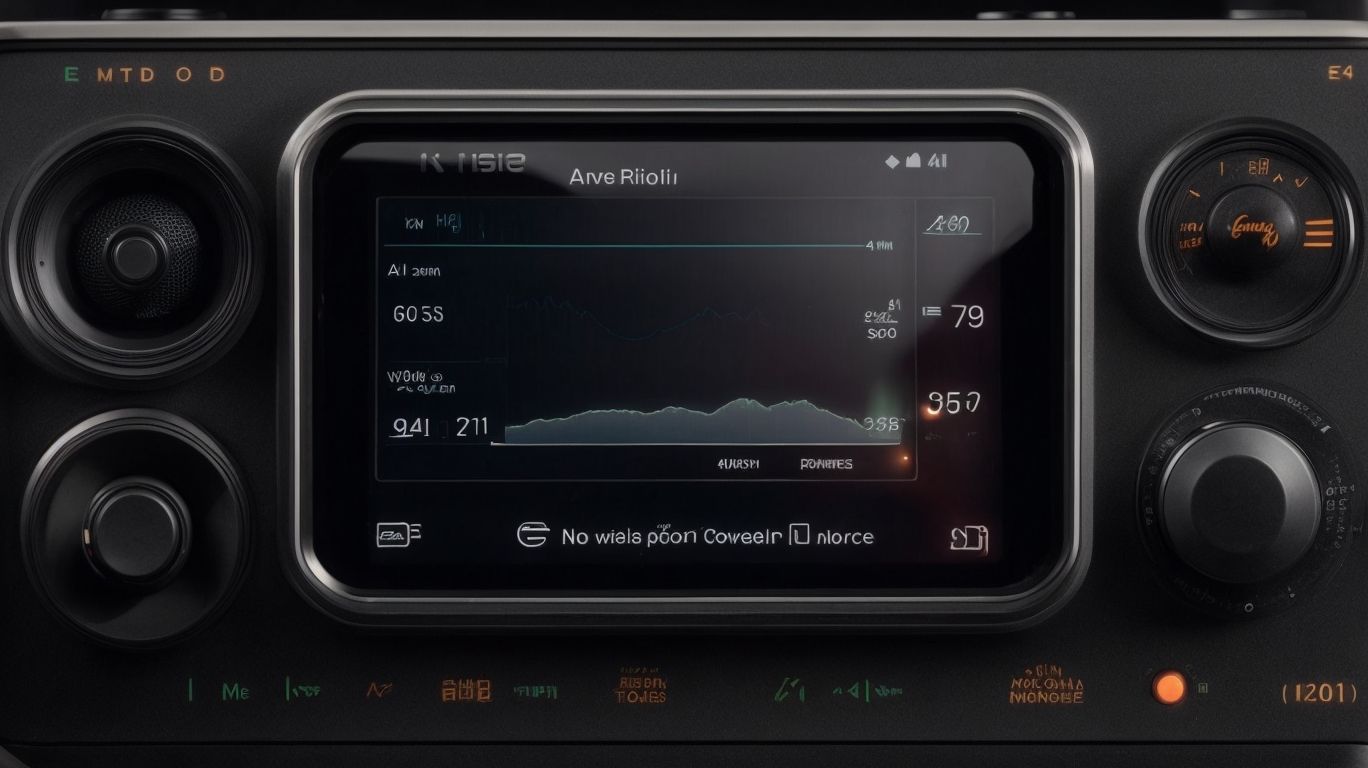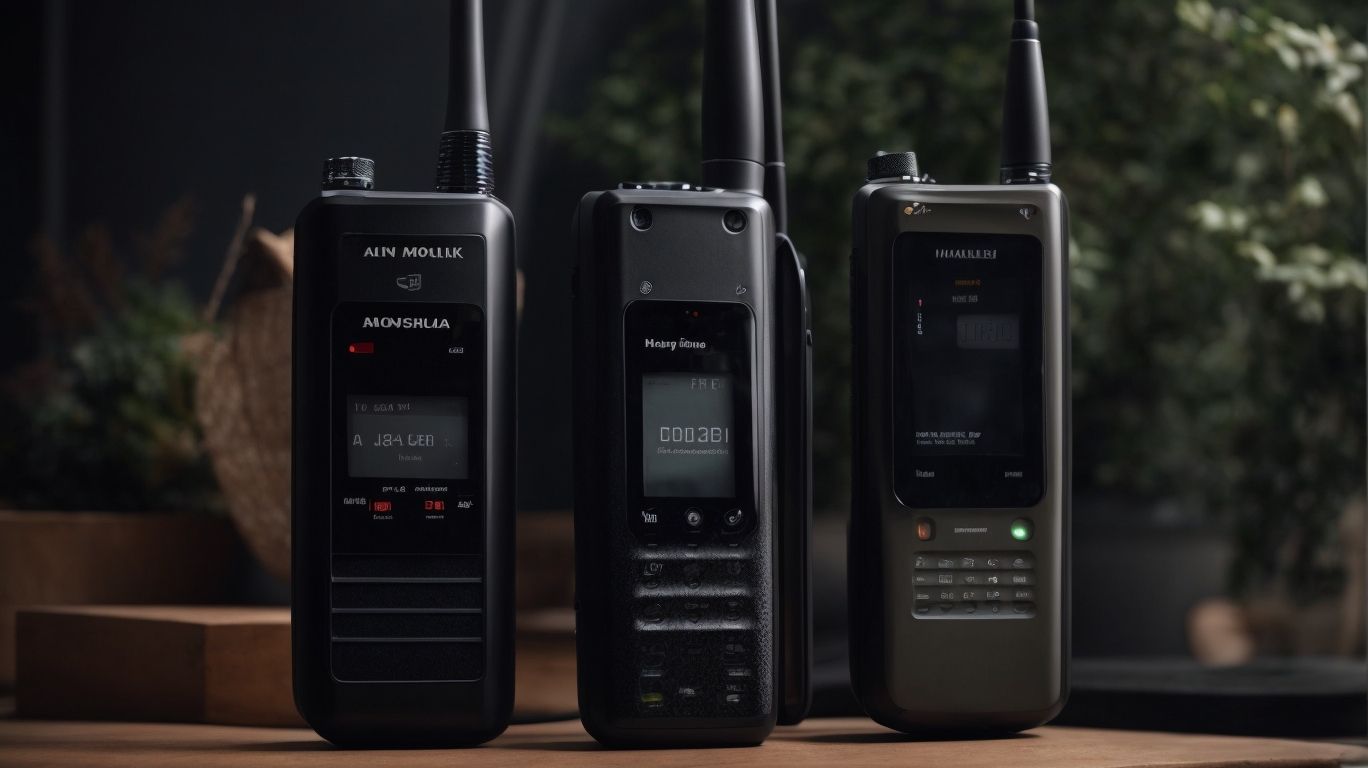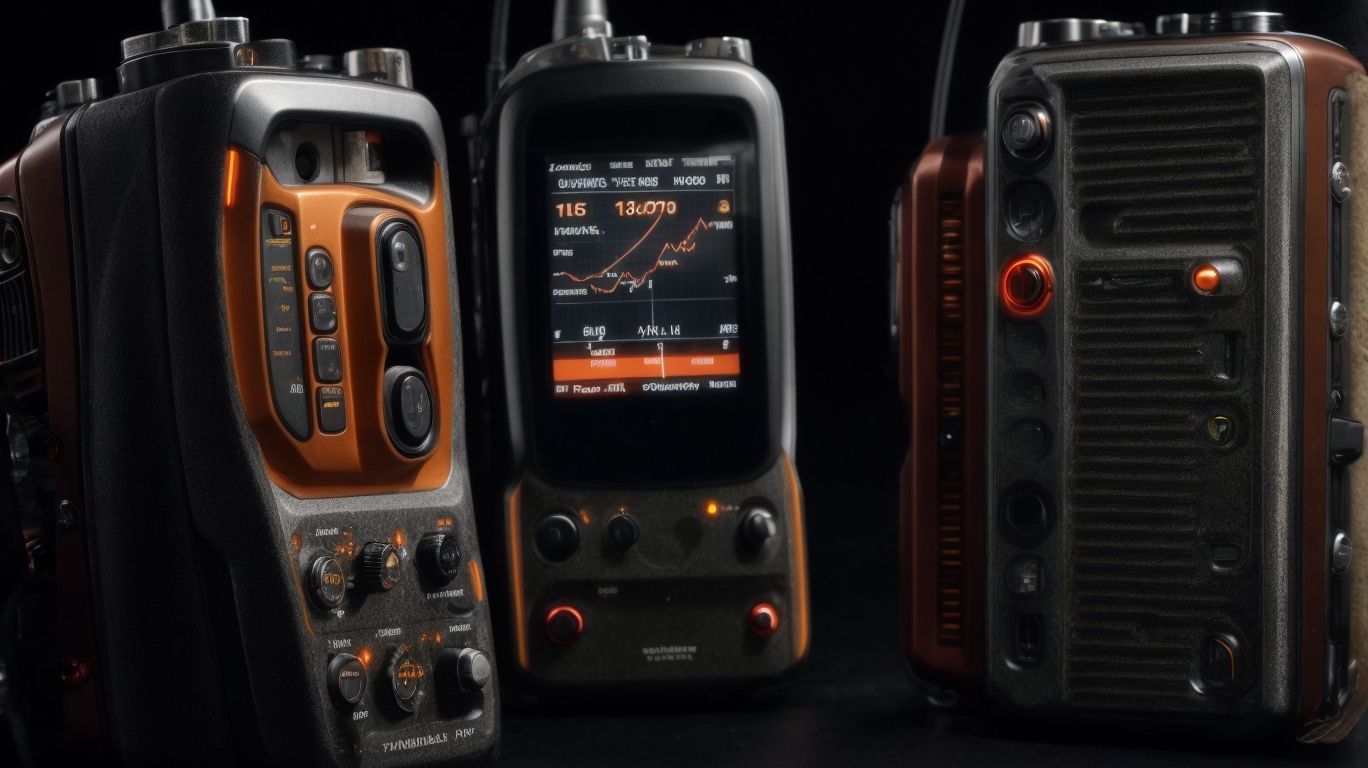.jpg)
Data modes in two-way radios refer to the different methods used to transmit and receive data. These modes can be either analog or digital, each offering unique advantages and capabilities. Understanding the various data modes is essential for beginners looking to utilize two-way radios effectively.
Analog data modes involve encoding data onto an analog signal, allowing for simple and straightforward communication. On the other hand, digital data modes utilize digital signals, enabling more complex and advanced data transmission. Each mode has its own set of benefits and applications.
The benefits of data modes in two-way radios are significant. Firstly, data modes enhance communication efficiency by allowing for faster and more accurate data exchange. Secondly, they enable enhanced data transmission, ensuring that information is relayed accurately and reliably. Lastly, data modes offer better signal quality, minimizing interference and improving overall communication clarity.
Some common data modes utilized in two-way radios include Frequency Shift Keying (FSK), Continuous Tone-Coded Squelch System (CTCSS), Trunked Radio System (TRS), and Microwave Data Interface (MDI). These modes differ in their modulation techniques and are chosen based on specific requirements and applications.
Choosing the right data mode for your needs involves several considerations. Factors such as communication range, signal interference, and data transmission speed should be taken into account. Evaluating these factors will help determine the most suitable data mode to achieve optimal performance and fulfill your communication requirements.
By familiarizing yourself with the fundamentals of data modes in two-way radios and understanding their benefits and applications, you can make informed decisions and effectively utilize these devices for seamless and efficient communication.
Key takeaways:
- Analog data modes in two way radios involve the use of continuous waveforms to transmit information. Digital data modes, on the other hand, convert data into binary code for transmission.
- Common data modes used in two way radios include frequency shift keying, continuous tone-coded squelch system, trunked radio system, and microwave data interface.
- When choosing the right data mode for your needs, factors to consider include communication range, signal interference, and data transmission speed.
What are Data Modes in Two Way Radios?

Photo Credits: Hrw.Hstng.Dev by Charles King
What exactly are data modes when it comes to two-way radios? Let’s dive into this fascinating aspect of communication. We’ll uncover the ins and outs of analog data modes, demystifying their functionalities and potential uses. We’ll embark on a journey to explore the world of digital data modes, discovering their advantages and how they revolutionize information exchange. Join us as we delve into the realm of data modes in two-way radios, unraveling its secrets along the way.
Understanding Analog Data Modes
Understanding analog data modes is critical in the world of two-way radios. Analog data modes are essential methods used to transmit and receive information via analog signals. Below is a table that highlights some common analog data modes:
| Analog Data Mode | Description |
| Frequency Shift Keying (FSK) | Modulates the frequency of the carrier signal to represent digital data. |
| Continuous Tone-Coded Squelch System (CTCSS) | Utilizes sub-audible tones to encode and decode audio signals. |
| Trunked Radio System | Allots specific frequencies to users dynamically for efficient communication. |
| Microwave Data Interface | Facilitates data transmission over microwave frequencies. |
Comprehending these analog data modes is crucial for selecting the appropriate mode based on communication range, signal interference, and data transmission speed. Take these factors into consideration to ensure effective and reliable communication.
Exploring Digital Data Modes
Exploring digital data modes in two-way radios provides efficient and reliable communication. These modes utilize digital technology to transmit data, offering enhanced features and capabilities. Here is a concise table highlighting some commonly used digital data modes in two-way radios:
| Digital Data Mode | Description |
|---|---|
| Frequency Shift Keying (FSK) | Modulates the carrier frequency to represent data |
| Continuous Tone-Coded Squelch System (CTCSS) | Uses sub-audible tones for selective signaling |
| Trunked Radio System | Efficiently allocates radio channels for multiple users |
| Microwave Data Interface | Transfers data using microwave frequencies |
Exploring digital data modes allows users to optimize their communication in terms of data transmission speed, communication range, and resistance to signal interference. By understanding the advantages and limitations of each data mode, users can choose the most suitable one for their specific needs.
If you’re feeling a little lost in the data world, these common data modes will guide you through the radio maze.
Common Data Modes Used in Two Way Radios

Photo Credits: Hrw.Hstng.Dev by Thomas Walker
Unlock the realm of two-way radios as we explore the common data modes that make communication seamless. From Frequency Shift Keying to Microwave Data Interface, we’ll dive into each sub-section, unveiling the wonders and possibilities they offer. Stay tuned to discover how these data modes revolutionize the way we connect and transmit information. No more communication barriers – let’s embark on this journey together!
Frequency Shift Keying
(FSK) is a commonly used data mode in two-way radios. It is a digital modulation technique that allows the transmission of digital information through changes in frequency. FSK works by shifting the carrier frequency between two predetermined frequencies to represent binary data.
FSK offers several advantages, such as efficient use of bandwidth, robustness against noise and interference, and ease of implementation. It is widely used in applications like wireless data communication, radio telemetry, and remote control systems.
Here is a table summarizing the characteristics of Frequency Shift Keying (FSK):
| Modulation Technique | Carrier Frequency | Advantages | Applications |
|---|---|---|---|
| Digital | Shifting between two frequencies | Bandwidth efficiency, noise resistance, easy implementation | Wireless data communication, radio telemetry, remote control systems |
By employing Frequency Shift Keying, two-way radios can achieve reliable and efficient data transmission in various scenarios. Silence is golden, but not when it comes to the Continuous Tone-Coded Squelch System in two way radios.
Continuous Tone-Coded Squelch System
The Continuous Tone-Coded Squelch System (CTCSS) is a common data mode used in two-way radios. It is a signaling method that allows multiple radios to use the same frequency while preventing interference from other users. CTCSS works by transmitting a specific tone along with the voice signal, which acts as a filter to only allow radios programmed with the same tone to receive the message. This ensures that only relevant communication is heard, reducing background noise and improving overall clarity. CTCSS is widely used in applications such as public safety, security, and amateur radio, where multiple users need to share frequencies.
Trunked Radio System: Where communication is so efficient, it’s like your messages are driving in the fast lane while everyone else is stuck in traffic.
Trunked Radio System
A Trunked Radio System is a communication system that efficiently utilizes limited radio frequencies. It employs a centralized control channel to coordinate communication among multiple users. Here is a table summarizing the key features of this system:
| Feature | Details |
|---|---|
| Dynamic Channel Allocation | Frequencies are allocated on demand, allowing for flexible communication. |
| Talk Group Organization | Users are grouped into talk groups based on their roles or departments. |
| Trunked Voice Channels | Multiple conversations can be carried out on a single frequency. |
| System-Wide Busy Tone | When all channels are in use, a busy tone informs users to wait for an available channel. |
| Automatic Channel Selection | The system automatically selects an available channel for each call. |
| Interoperability | Trunked radio systems can be designed to work across different agencies or organizations. |
A Trunked Radio System offers efficient and reliable communication, making it beneficial for organizations that require frequent and simultaneous voice communication among numerous users.
Get ready to heat things up with the Microwave Data Interface, because communication just got a little bit hotter.
Microwave Data Interface
The microwave data interface is a key component of data modes in two-way radios. It allows for high-speed data transmission over microwave frequencies, enabling efficient and rapid communication between devices.
Here is a table showcasing the importance of the microwave data interface:
| Data Mode | Communication Range | Signal Interference | Data Transmission Speed |
| Microwave Data Interface | Long-range capabilities | Minimal interference | High-speed transmission |
Considering these factors, the microwave data interface is ideal for scenarios requiring long-range communication, minimal signal interference, and fast data transmission. It is a reliable choice for applications such as emergency services, military operations, and large-scale event coordination.
Choosing the right data mode, including the microwave data interface, is crucial to ensure effective communication based on specific needs and requirements. Assessing communication range, signal interference, and data transmission speed will help determine the most suitable data mode for optimal performance. When it comes to choosing the right data mode for your needs, remember: it’s all about finding that perfect match, like two way radios and a sense of humor in a dark room.
Choosing the Right Data Mode for Your Needs

Photo Credits: Hrw.Hstng.Dev by Wayne Perez
Selecting the perfect data mode for your two-way radio can make all the difference in effective communication. In this section, we’ll explore how to choose the right data mode to meet your specific needs. From assessing communication range to considering signal interference and data transmission speed, we’ll delve into the key factors that will help you make an informed decision. So, let’s dive in and find the data mode that will elevate your two-way radio experience!
Determining Communication Range
Determining the communication range of your two-way radio is essential for guaranteeing effective and reliable communication. To help you establish the range, follow these steps:
- Thoroughly research the specifications of your two-way radio, including the power output and antenna gain.
- Take into account any obstacles or terrain that may have an impact on the range, such as buildings or mountains.
- Consider the frequency band used by your radio, as different frequencies possess varying propagation characteristics.
- Conduct a range test by selecting a location with a clear line of sight and assessing the communication distance between two radios.
In a gripping tale, a team of hikers embarked on a treacherous journey through a remote mountain range. Relying on their two-way radios, they astutely considered the specifications of their devices and comprehensively evaluated the terrain. By doing so, they successfully established a dependable communication range spanning several miles. This enabled them to ensure their safety and coordinate effectively throughout their thrilling adventure.
Considering Signal Interference
“`
- When selecting the right data mode for your two-way radios, it is essential to consider signal interference.
- Here are the steps to take when evaluating signal interference:
- Survey the area to assess the potential sources of interference in the surrounding environment.
- Choose a data mode that operates on a frequency band less susceptible to interference.
- Explore data modes with features like frequency hopping or spread spectrum techniques that minimize or eliminate interference.
- Consider data modes that offer filtering capabilities to reduce unwanted signals or noise.
- Conduct field tests to evaluate the performance of different data modes in the presence of interference.
By following these steps, you can make an informed decision and select a data mode that effectively manages signal interference for your two-way radios.“`
Assessing Data Transmission Speed
To ensure smooth and efficient data transmission, it is important to assess the data transmission speed. When choosing a data mode for two-way radios, consider factors such as the baud rate, bit rate, and latency. These factors play a crucial role in determining how quickly data can be transmitted and received.
Below is a table highlighting different data modes and their corresponding data transmission speeds:
| Data Mode | Data Transmission Speed (in bits/sec) |
| Frequency Shift Keying | Up to 1,200 |
| Continuous Tone-Coded Squelch System | Up to 2,400 |
| Trunked Radio System | Several thousand |
| Microwave Data Interface | Up to 2,048,000 |
When assessing data transmission speed, it is essential to consider factors such as the amount and frequency of the data being transmitted, as well as the distance over which the communication will take place. These factors will help in determining the most suitable data mode that meets your specific needs.
Some Facts About Beginner’s Guide to Data Modes for Two Way Radios:
- ✅ Two-way radios are widely used for communication worldwide due to their functionality, versatility, and reliability. (Source: Our Team)
- ✅ They are called “two-way” radios because they can both send and receive signals, enabling bidirectional voice communication. (Source: Our Team)
- ✅ The first true two-way radio was used commercially in 1923, although transmitters and receivers for two-way communication were used as early as the 1900s. (Source: Our Team)
- ✅ Early versions of two-way radios did not allow for voice communication and instead relied on codes like Morse Code. (Source: Our Team)
- ✅ Canadian inventor Don Hings played a key role in the development of walkie talkies, creating portable radio signaling systems initially for pilots and later for soldiers during World War II. (Source: Our Team)
Frequently Asked Questions
What are two-way radios?
Two-way radios are communication equipment that can both send and receive signals, allowing bidirectional voice communication. They are widely used worldwide due to their functionality, versatility, and reliability.
Who invented the first true two-way radio?
The first true two-way radio was invented by Canadian inventor Don Hings, who played a significant role in the development of portable radio signaling systems. He initially designed them for pilots and later for soldiers during World War II.
What are the different frequency bands used in two-way radios?
Two-way radios operate in various frequency bands, including VHF (Very High Frequency) and UHF (Ultra High Frequency). These bands use lower frequencies and have different characteristics, such as penetrating power and range.
What is the purpose of voice scramblers and power supplies in portable radios?
Voice scramblers and power supplies are features found in portable radios, particularly in models like the iconic Model C-58 Pack Set. Voice scramblers enhance secure communication by encoding voice signals, while power supplies ensure uninterrupted operation of the radio.
Are there alternatives to two-way radios for outdoor communication?
Yes, there are alternatives to two-way radios for outdoor use. Some options include cell phones, satellite radios, and LTE (Long-Term Evolution) communication devices. However, each alternative has its limitations and suitability depending on the specific communication needs.
Why is FCC licensing important for certain two-way radios?
FCC licensing is important for certain types of two-way radios, especially those operating on specific frequency bands. Obtaining an FCC license ensures compliance with regulations and allows for authorized and uninterrupted use of the radio equipment.